It started as an ordinary Wednesday morning on Broadway. By noon, one man’s two-hour wait on the pavement — surrounded by five NYPD officers and no ambulance — had exposed the limits of a city that has spent years promising new hubs and crisis-response fixes. We asked the people in charge for an explanation.
I was on my way to a 10am doctor’s appointment on Broadway between W38th and 39th Streets last Wednesday when I first heard the sound — a police car racing down the bike lane. Moments later, I saw officers struggling with a man as he foamed at the mouth and shouted incoherently. It was 9:55am. I sent the video I took of the incident to my Deputy Editor, with a note about this is what happens east of 8th Avenue (where W42ST’s news coverage typically ends) and headed to my appointment.
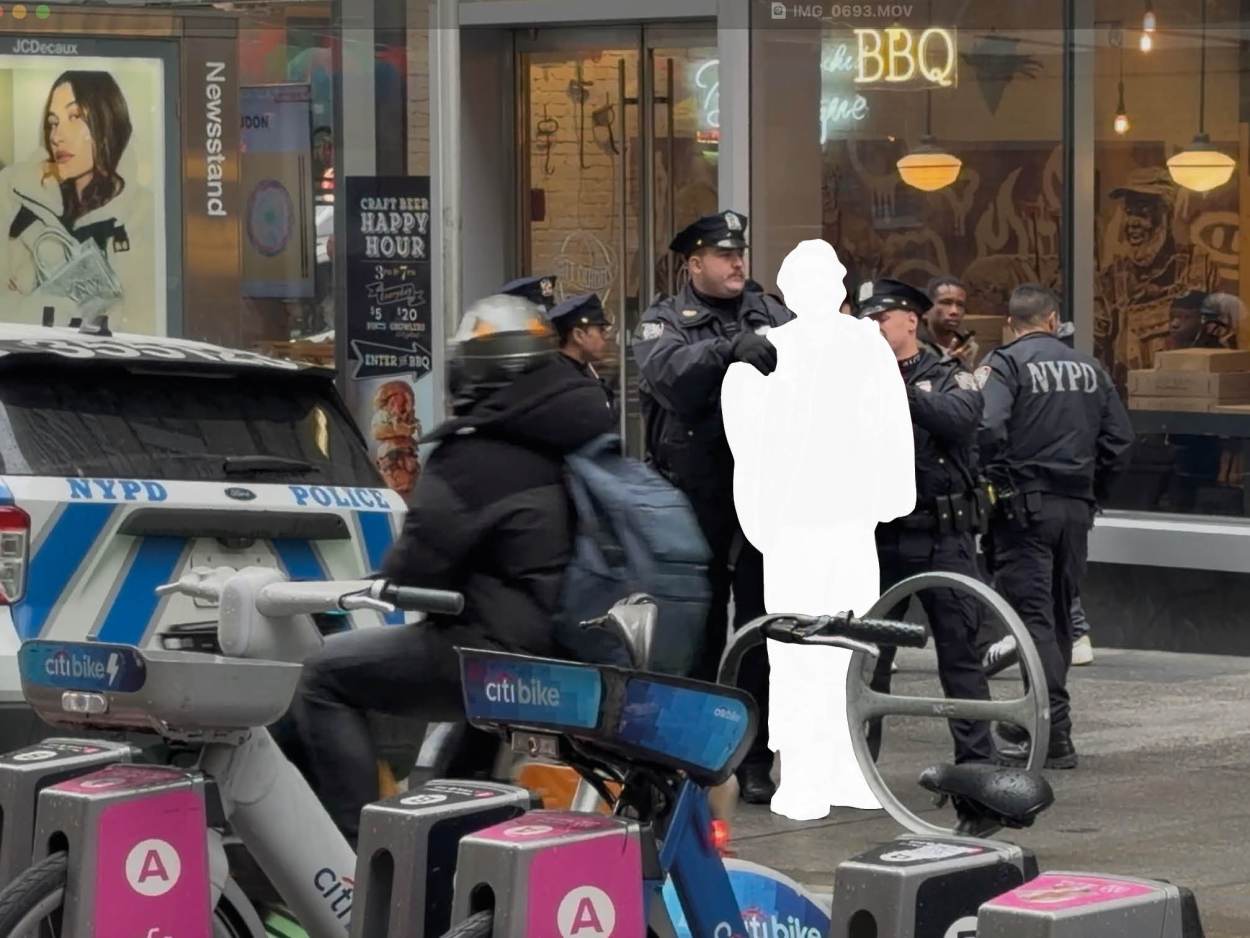 9:55am Wednesday November 19: A man is detained on Broadway as a police vehicle arrives. Photo: Phil O’Brien
9:55am Wednesday November 19: A man is detained on Broadway as a police vehicle arrives. Photo: Phil O’Brien
When I came back out of the doctor’s office at 10:48am, I was shocked that not much had changed — except the police car had gone. Five NYPD officers were still standing around with the man now lying on the sidewalk, temperatures in the low 40s, waiting for help that wasn’t coming. One officer told me: “He’s not under arrest. We’ve been waiting since 9:51. Exactly an hour. He can’t take care of himself. We sent for an ambulance.”
I watched from the warmth of a nearby coffee shop as the officers — patient, calm and increasingly resigned — continued to wait. The man continued to struggle and thrash around on the ground. At 11:24am, they helped the man sit up. By 11:51am, two full hours after the initial call, there were still five officers on scene. Finally, at 12:11pm, a Midtown North Precinct patrol car arrived, and the man was bundled into the back. One of the officers told me the wait was “not uncommon.”
For a problem area of New York City with a Midtown Hub, B-HEARD teams, task forces, working groups, and press conferences promising coordinated, humane alternatives to police-led intervention, the reality on Broadway offered none of it. One troubled New Yorker in crisis. Five police officers immobilized for two hours. No ambulance.
New Yorkers see scenes like this every day. Most of us have learned to shrug. This time, I wanted to know who the man was — and what actually happens to people like him when the system designed to help doesn’t show up.
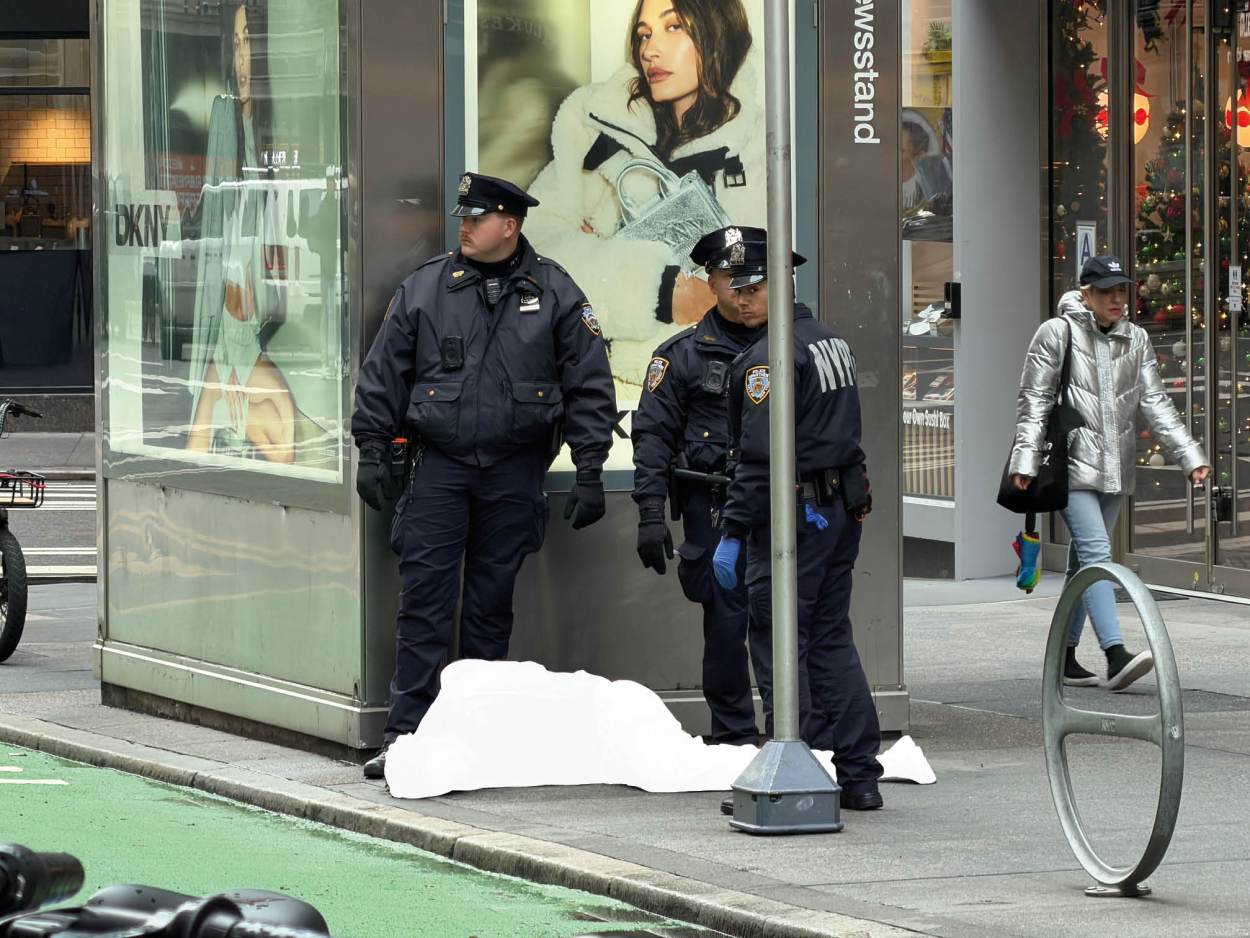 10:48am Wednesday November 19: The same man is on the Broadway sidewalk as police wait for an EMS vehicle to arrive. Photo: Phil O’Brien
10:48am Wednesday November 19: The same man is on the Broadway sidewalk as police wait for an EMS vehicle to arrive. Photo: Phil O’Brien
In our investigation, we learned the man on the sidewalk is a former New York City foster youth whose life began in unimaginable trauma: sold into domestic slavery in Tunisia as a child, later brought to the United States, and at age nine severely beaten by the adults caring for him in Queens — an assault that left him hospitalized and led authorities to place him in the city’s foster care system. He aged out without family support, drifting through supportive housing and sporadic work. Friends knew him for an upbeat smile that hid instability. His social media showed glimpses of making music and time with his young son before falling silent in 2021. More recently, he had been a client of BRC’s subway outreach program — a system intended to keep people like him off the streets and out of crisis. BRC did not respond to a request for comment.
What happened on Broadway suggested something different. Not a failure of compassion, but a failure of coordination.
We wrote to City agencies, elected officials and Midtown Hub leaders to get questions answered and try to understand what had gone on. They responded to W42ST’s questions about the two-hour wait — and what should have happened instead. Here’s what they told us:
 Elected officials and community stakeholders at a public safety press conference in Times Square in December 2024 — (from left) Senator Brad Hoylman-Sigal, Assemblymember Tony Simone, DA Alvin Bragg, Times Square Alliance President Tom Harris, Councilmember Erik Bottcher and NYC Mayor Eric Adams. Photo: Phil O’Brien
Elected officials and community stakeholders at a public safety press conference in Times Square in December 2024 — (from left) Senator Brad Hoylman-Sigal, Assemblymember Tony Simone, DA Alvin Bragg, Times Square Alliance President Tom Harris, Councilmember Erik Bottcher and NYC Mayor Eric Adams. Photo: Phil O’Brien
Times Square Alliance President / Midtown Hub co-chair Tom Harris
Tom Harris, president of the Times Square Alliance and co-chair of the Midtown Community Improvement Coalition (the Midtown Hub), said that while the incident unfolded just outside the Hub’s formal boundaries, the partners still see it as part of their scope:
“The Midtown Hub was formed to coordinate city services to address perennial conditions in the neighborhood. The catchment area is from 7th Avenue to 9th Avenue from 35th to 59th Street. Though not directly in the catchment area, we feel that not responding would not be the right thing to do given that the issue is so important.”
Harris said the Hub’s work is largely proactive, focused on “identifying individuals, building trust, and providing them with services and support,” and that the man on Broadway was “not known to us.” In cases like this, he said, emergent issues are handled by NYPD, which coordinates ambulance response.
He added that the episode shows “we have more work to do,” praising the officers on scene and sketching a vision of a more accountable, data-driven model:
“The NYPD showed extreme compassion by remaining and ultimately taking the individual to the hospital. Our vision is for there to be a system in place where data is shared amongst the partners, we focus on the individual in need, agencies and providers are held accountable for results, and we relentlessly follow up on care plans for the individuals. We look forward to working with the new administration to build on our successes and create a better outcome for those suffering on our streets.”
In a phone conversation, Harris shared a memory from his time leading operations at the Times Square Alliance — one that still shapes how he sees the city’s response today:
“I remember waiting six hours for help for a woman who was biting the heads off pigeons. Another time, we waited four hours for an ambulance to come. A high-ranking member of the NYPD and a rep from the Mayor’s Office were out with us, trying to call it in, but it wasn’t considered a priority. So nothing happened. We have people out on the street because they’re not a priority, and it’s time we make them a priority.”
Harris said he is hopeful that the incoming administration will treat those moments differently:
“We’re hopeful that Mayor-elect Mamdani will give people dignity — and prioritize their getting service and support.”
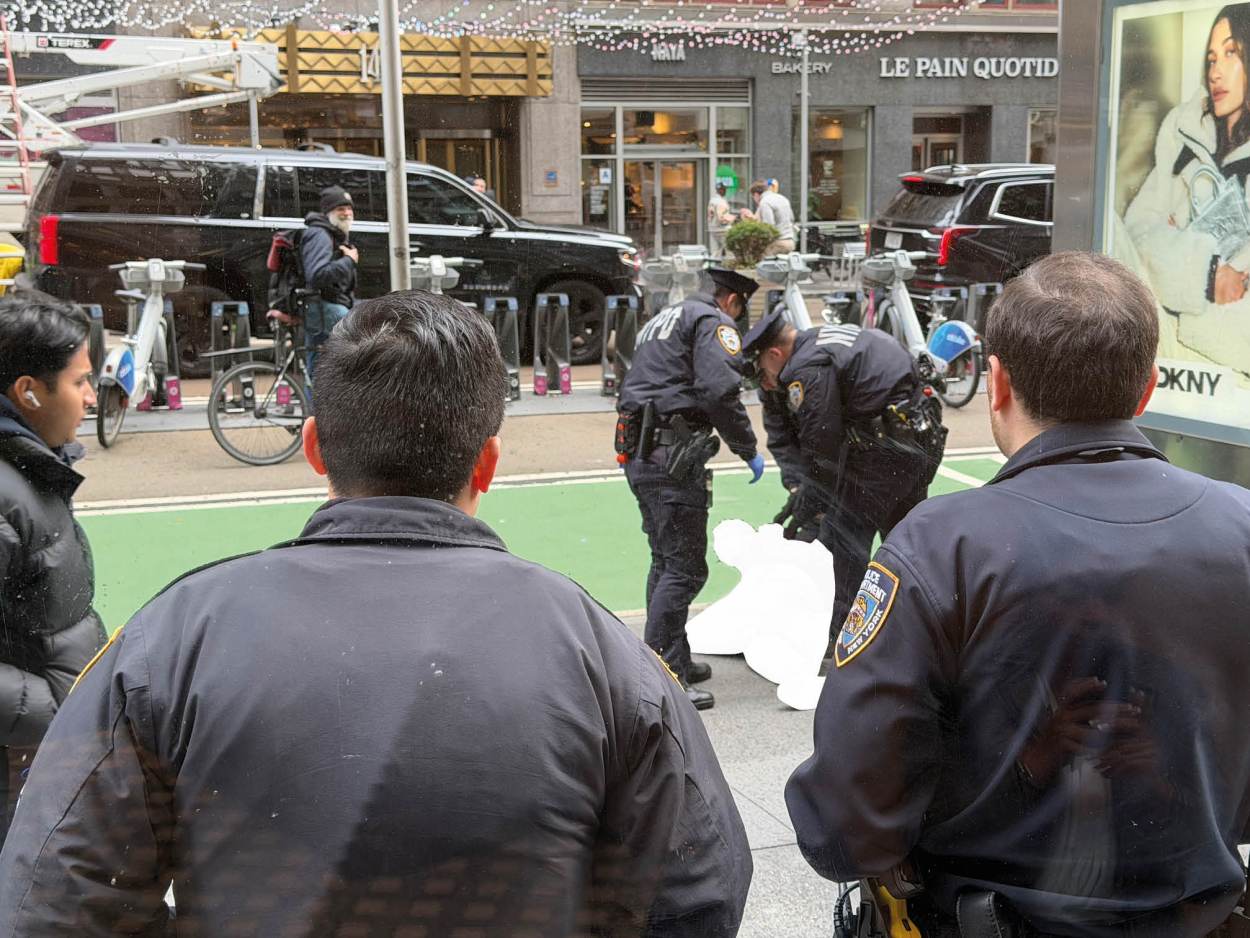 11:16am Wednesday November 19: The man continues to writhe and thrash out on the Broadway sidewalk as five cops wait for an EMS vehicle to arrive. Photo: Phil O’Brien
11:16am Wednesday November 19: The man continues to writhe and thrash out on the Broadway sidewalk as five cops wait for an EMS vehicle to arrive. Photo: Phil O’Brien
NYPD (DCPI)
In a short statement, NYPD’s Deputy Commissioner of Public Information confirmed their response:
“On Wednesday, November 19, 2025, at approximately 0950 hours, officers from the Midtown South Precinct had a pick-up of an aided male. The male was transported by police vehicle to NYC Health and Hospitals/Bellevue for an evaluation.”
Councilmember Erik Bottcher
Councilmember Erik Bottcher responded by sending a formal letter to Mayor Eric Adams, calling the Broadway incident evidence of a “system in gridlock” and demanding a full accounting from the administration.
Bottcher noted that five NYPD officers waited for more than two hours with a man in clear mental distress, despite the individual not being under arrest and simply needing transport to a hospital. He described the outcome — a police vehicle eventually used instead of an ambulance — as both “heartbreaking” for the individual and a “profound misuse of public safety resources.”
In his letter, Bottcher pressed the Mayor for answers, including:
why EMS failed to arrive in Midtown Manhattan for more than two hours,
why officers were tied up managing a medical situation they are not trained to handle, and
what protocols governed the decisions made at the scene — and whether they were followed.
Bottcher reiterated his long-standing call for immediate expansion of the B-HEARD program into District 3 and warned that the status quo is “dangerously inadequate”:
“We must not grow accustomed to this dysfunction. When we become numb to suffering, we lose both our empathy and our responsibility to act.”
He requested a prompt response, outlining what went wrong and what corrective steps will be taken to prevent a repeat.
 Councilmember Erik Bottcher sent a letter to Mayor Adams about the incident. Photo: Phil O’Brien
Councilmember Erik Bottcher sent a letter to Mayor Adams about the incident. Photo: Phil O’Brien
FDNY
FDNY called the episode “an unusual situation,” emphasizing that police ultimately ensured the man got to the hospital:
“We will always work to keep every New Yorker safe and responding to all medical emergencies quickly and with care is our top priority. This was an unusual situation, and our partners at the NYPD ensured this patient was appropriately transported.”
Further inquiries explained that the city’s B-HEARD teams are not dispatched when 911 calls mention that a patient is combative, violent or behaving erratically.
Garment District Alliance / Midtown Hub co-chair Barbara Blair
Barbara Blair, president of the Garment District Alliance and a Midtown Hub co-chair, called the incident “troublesome under any circumstances, and regrettable,” and said she could not speak as to why EMS never arrived.
“For my part, I am amazed that the NYPD stayed with the individual, in the cold, for two hours and then finally resorted to remedying the situation themselves.”
Blair strongly defended the Midtown Hub’s record in her district:
“The Garment District is perhaps one of the most stressed districts in NYC and certainly the most stressed in Manhattan below 96th Street by a long shot. The improvements that we have seen over the last 18 months are dramatic — but more importantly, the collaboration that I am experiencing between NYC agencies, social service outreach workers and others has had tangible results.”
She said ongoing “anti-social conditions” stem from broader policy failures, not the Hub’s work, and concluded:
“I can only say that the activities of the HUB have had a profound and positive impact on the Garment District, and we hope that this collaboration continues.”
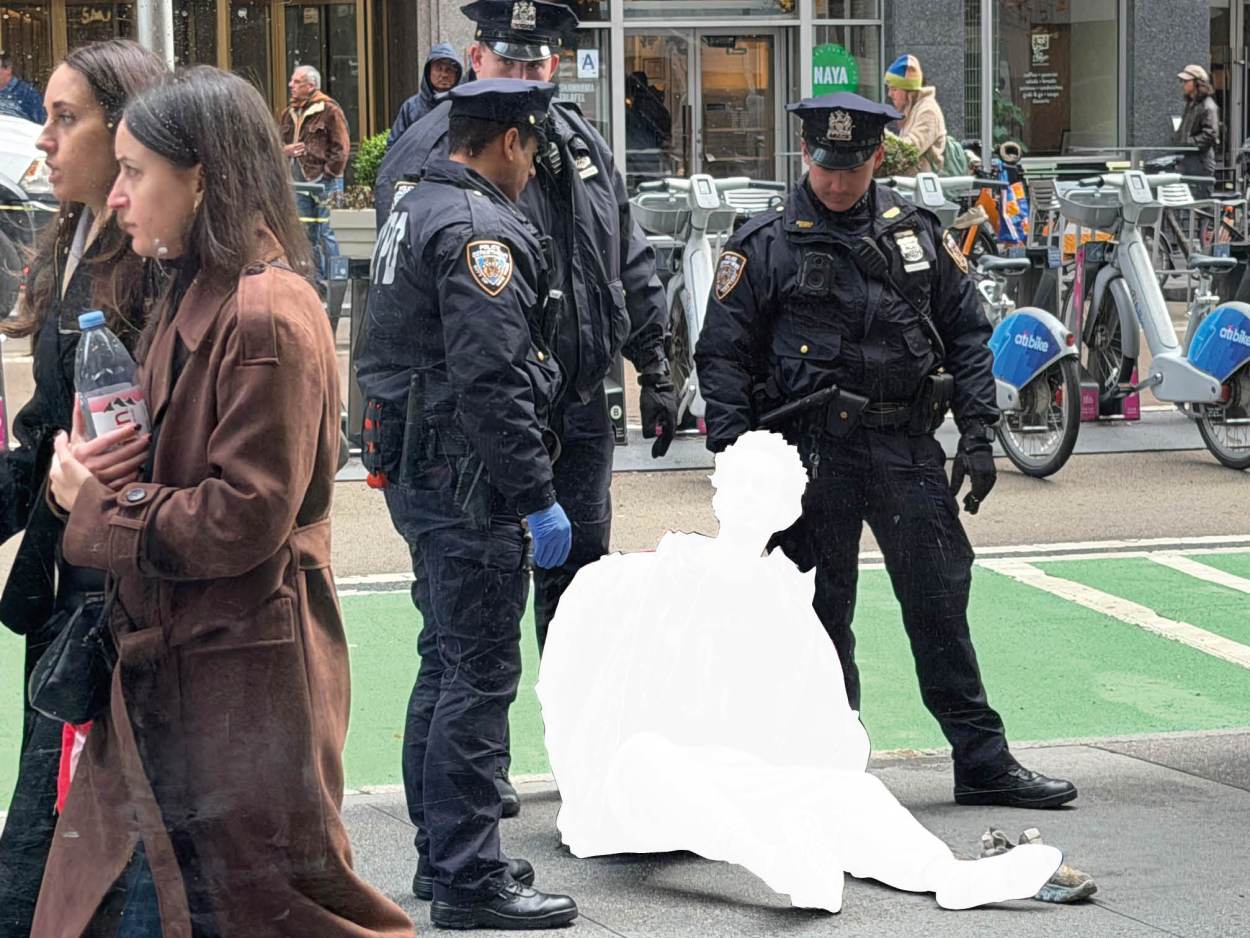 11:24am Wednesday November 19: The detained man is allowed to sit up on the Broadway sidewalk as the wait continues. Photo: Phil O’Brien
11:24am Wednesday November 19: The detained man is allowed to sit up on the Broadway sidewalk as the wait continues. Photo: Phil O’Brien
Assemblymember Tony Simone
Assemblymember Tony Simone framed the two-hour wait on Broadway as evidence of issues within the city’s mental health system:
“This incident is yet another example of the glaring gaps in our mental healthcare system. When a person in crisis needs immediate assistance, systemic weak points are often revealed. In this specific case, NYPD officers responded but were not aided by mental health professionals and faced an overloaded medical response time.”
He added: “This is why I support Mayor-elect Mamdani’s proposed Department of Community Safety to scale up city responses to these situations, fully integrated into the 911 response system.”
He also pointed to his own push to fund licensed psychiatric professionals on street outreach teams, and to address the workforce crisis in EMS:
“Low pay and high turnover has led to a shortage of EMTs and ambulance drivers… They deserve to be paid at a level that reflects the critical work they provide, and New Yorkers deserve to feel they can rely on ambulances to respond promptly to their emergencies.”
On behalf of the Midtown Community Improvement Coalition, led out of the Manhattan District Attorney’s Office, a spokesperson emphasized the coalition’s collaborative model and praised the officers on scene:
“We commend the responding officers for demonstrating compassion and care. The Coalition’s collaborative and proactive approach means our members – from the NYPD to city agencies and community-based organizations – are constantly sharing real-time information to identify people in need.”
The coalition highlighted its track record:
“Outreach workers then engage, build trust and refer them for services, such as stable housing or mental health treatment. The Coalition has successfully referred nearly 250 people for supportive housing and shelter placements or hospitalization. As this is a collaborative model, we continue to fine-tune our approach and build on this success.”
State Senator Brad Hoylman-Sigal — Manhattan Borough President-elect
State Senator Brad Hoylman-Sigal, who will soon become Manhattan Borough President, tied the incident to the need for a true “clinical” response system:
“As Manhattan Borough President-elect, I look forward to working closely with Mayor-elect Mamdani in implementing his proposed Department of Community Safety, which promises to put clinicians — not just an already overextended police force — in charge of behavioral health crises and help reform New York City’s disjointed mental health system.”
He argued that under current dispatch rules, most mental-health 911 calls are treated as either medical transports or police matters, and end up in an overburdened EMS queue — with NYPD as default transport when ambulances don’t arrive on time:
“In cases where an ambulance does not timely arrive, NYPD becomes the default transport option under the mental hygiene law, despite not being designed or trained to provide clinical crisis care.”
Hoylman-Sigal pointed to efforts like the Midtown Community Improvement Coalition, the Midtown Community Justice Center and the Daniel’s Law Task Force as early steps toward a “health-led, standardized crisis response model,” but said much more investment is needed.
“New Yorkers have been begging for coordinated reforms across our mental health system so that incidents like this one, where an individual is left in crisis for hours and our officers are immobilized, can be left in the past. I am committed to making this a reality.”
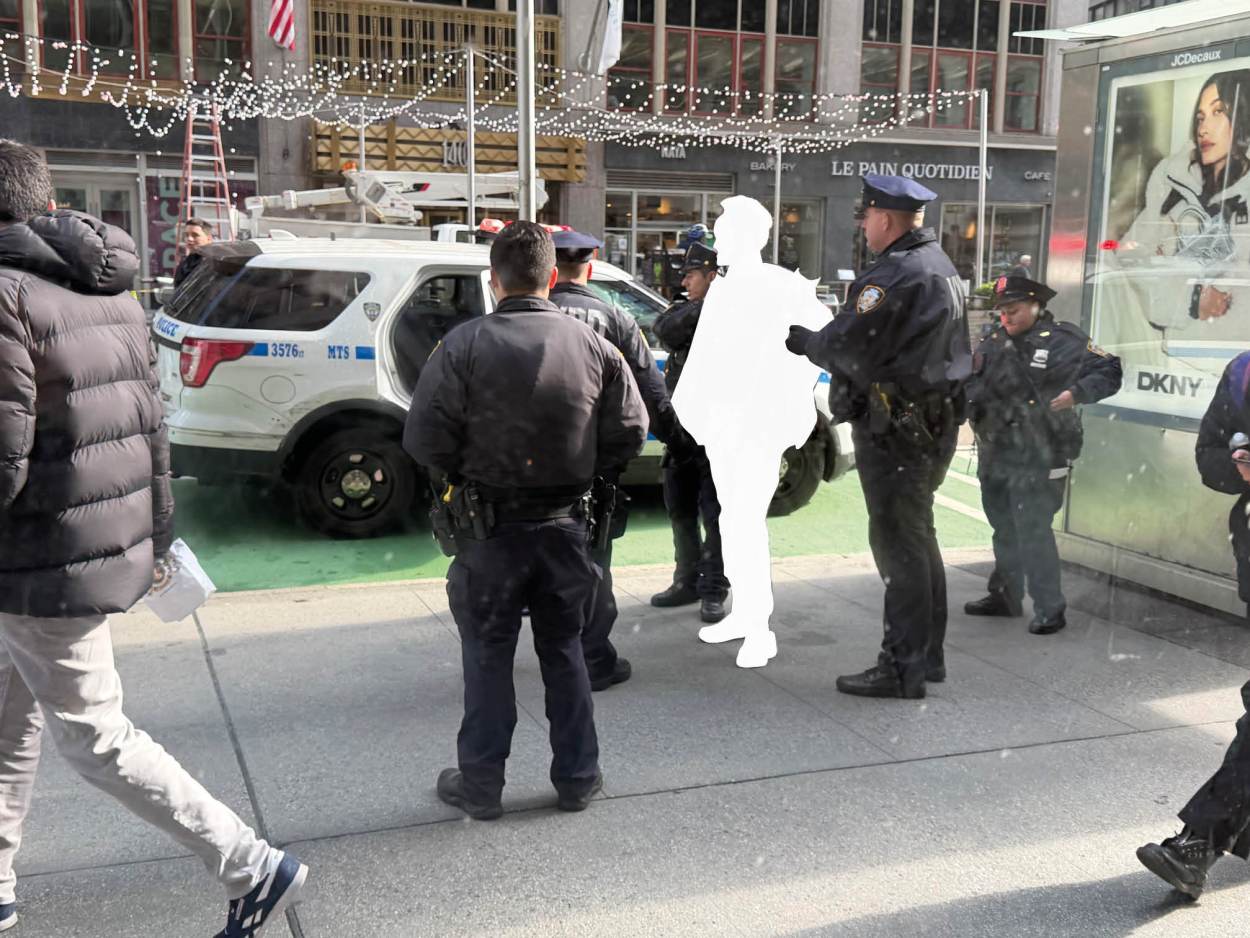 12:11pm Wednesday November 19: The man is finally taken from the scene to hospital in an NYPD vehicle. Photo: Phil O’Brien
12:11pm Wednesday November 19: The man is finally taken from the scene to hospital in an NYPD vehicle. Photo: Phil O’Brien
Gloria Gong, Government Performance Lab at Harvard Kennedy School
While the offices of Mayor Eric Adams and Mayor-elect Zohran Mamdani did not respond before publication, W42ST spoke with Gloria Gong, executive director of the Government Performance Lab at Harvard University’s Kennedy School of Government, whose recent Vital City op-ed on Mamdani’s proposed Department of Community Safety resonated with the Broadway incident.
Gong warned that without ownership across systems, people with severe mental illness will not receive the help they need:
“People with severe mental illness are falling through the cracks between the health, criminal justice and homelessness systems. Mayor-elect Mamdani has proposed expanding alternative response, mobile health care and voluntary peer-led services, but what we’ve seen from working with cities across the country on these types of programs is that it’s not enough to create new seats in services. Someone has to be accountable for supporting these folks through their full journey to treatment and housing, otherwise each part of the system accidentally drops them at the handoffs and they just end up cycling back through.”
In her op-ed, Gong argues that community responder teams are vital, but they are only the “front door” of care — not the long-term support needed to keep people from returning again and again to the streets and subways.
What unfolded on Broadway wasn’t about bad actors — it was about a system that still can’t carry people past the crisis point. As Gloria Gong wrote in her Vital City op-ed, “community responder teams do not provide long-term treatment for mental health and homelessness any more than EMTs provide ongoing care for cardiac health after responding to a heart attack.”
The analogy hit home for me. Four years ago, I survived a heart attack because EMTs got to me fast — but they didn’t walk me back to health. Specialists did. Long-term care did. A system that stayed with me after the emergency did. It still does.
The man on Broadway deserved the same continuity: not just rescue, but follow-through. I am sure this street pickup and short-term processing through the system were not his first rodeo.
Until New York builds a response that doesn’t end when the sirens fade — or never arrive — scenes like this won’t be rare. They’ll remain part of the city we’ve learned to look away from. And that should no longer be acceptable.
